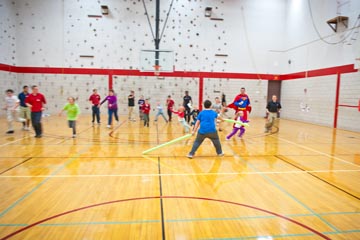Bulletin News

06/07/2016
The physical education classroom can be a scary place for young students who identify as transgender. Fortunately, there are steps that preservice and elementary school teachers can take to calm those fears.
That’s according to an article published in the Journal of Physical Education, Recreation & Dance earlier this year that counts a SUNY Cortland faculty member and student among its authors.
John Foley, a professor of physical education, and Court Pineiro, an outdoor recreation major who identifies as transgender, co-authored the piece along with Melissa Foley, the College’s former field experience coordinator for physical education, and Dan Miller, an elementary school physical education teacher in Ithaca, N.Y.
The article’s intention was to help teachers work successfully with elementary school students who identify as transgender. Two different perspectives were offered: a current teacher’s, from Miller, and a student teacher’s, which Pineiro provided as someone who identified as transgender from an early age.
“We realized that we need this type of training in our field,” John Foley said. “That’s really how this article germinated.”
It’s common for teachers to assume that gender identity questions start in the middle school years or later, but the truth is that they often come up at a younger age, according to the article. Multiple studies suggest that many teachers and school administrators are not educated in lesbian, gay, bisexual, transgender and queer (LGBTQ) issues, nor are they fully trained in creating the type of environment that experts say children who are transgender need to succeed.
“To be completely honest, even I didn’t realize children identify as early as they do,” Foley said.
Foley said he remembers the discussion that prompted Pineiro to speak up in a physical education class focused on skills assessment. Other students were having difficulty conceptualizing what it’s like to work with a student who is transgender. That’s when Pineiro, who was born a female but started self-identifying as a male in kindergarten, shared his experience with classmates.
“I thought it was courageous,” Foley said. “Court’s a strong advocate for transgender rights, and it showed in that moment.”
According to the SUNY Cortland research team’s work, determining what is right for all children can be difficult. Personal beliefs sometimes conflict with fair and appropriate action. Students who are transgender and their parents might also receive mixed messages from different groups — full acceptance by some and hostility from others.
In the article’s student perspective, Pineiro offered teachers the following tips:
- Ask students for their nickname or preferred name during attendance on the first day of class, or give them the opportunity to share it in private. This establishes openness and acceptance from the start.
- Use a student’s preferred pronouns if they are known. Mistakes will happen. Corrections and quick apologies always are a good idea.
- Never create groups in a classroom by sorting students exclusively by their gender. Divide them in other ways.
- Bathrooms and locker rooms can create high levels of anxiety. Allowing a separate bathroom to be used for changing clothes can be helpful if students feel uncomfortable. Unisex bathrooms in a nurse’s office offer another alternative.
- Always intervene and follow up with students who are transgender if bullying takes place. This requires more than simply telling bullies to stop. It means following up with students who are bullying and taking appropriate action.
The Centers for Disease Control and Prevention report that students who identify as transgender show a higher risk of being bullied or committing suicide. But physical education teachers in particular assume a unique position to address the negativity that LGBTQ students sometimes face.
The teacher’s perspective that Miller prepared offered additional tips for educators working with students who are transgender. Those suggestions include the elimination of allowing students to pick teams; the creation of a universal bathroom for students who prefer not to use the one for their assigned sex; and the establishment of unified, school-wide communication that promises a comfortable environment for students of all genders.
More resources for teachers and school administrators can be found on the CDC website, the Gay, Lesbian and Straight Education Network and “Stop Bullying,” a website intended to help teachers promote a safe classroom environment.

